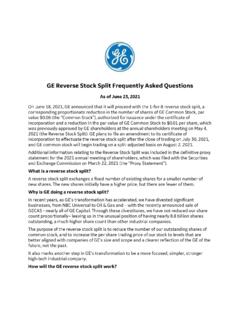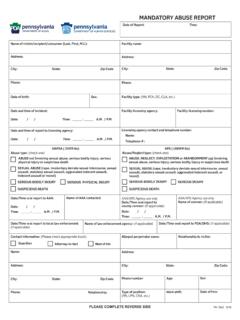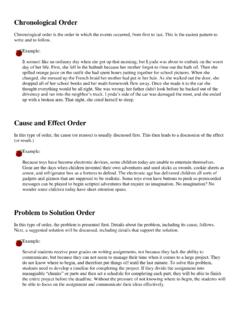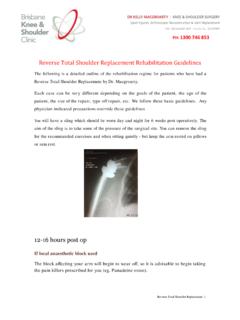Transcription of RT-PCR: Two-Step Protocol - MIT OpenCourseWare
1 RT-PCR: Two-Step Protocol We will provide both one-step and Two-Step protocols for RT-PCR. We recommend the Two-Step Protocol for this class. In the one-step Protocol , the components of RT and PCR are mixed in a single tube at the same time. The one-step Protocol generally works well for amplifying targets that are reasonably abundant. Alternatively, RT-PCR can be done in two steps, first with the reverse transcription and then the PCR. The Two-Step Protocol is usually more sensitive than the one-step method; yields of rare targets may be improved by using the Two-Step procedure. One-step RT-PCR: Convenient RNA RT + PCR RT-PCR product of your gene of interest Two-Step RT-PCR: Saves RT reagents. One RT reaction will provide templates for multiple PCR s Can be more sensitive than one-step RT-PCR PCR for Gene X RT-PCR product of Gene X RT PCR for Gene Y RNA cDNA pool RT-PCR product of Gene Y PCR for Gene Z RT-PCR product of Gene Z Two-Step Protocol Step One: Reverse Transcription Note: Wear gloves at all times to avoid RNase contamination Reagents: RETRO script kit from Ambion, Catalogue # 1710 -Reverse Transcriptase MMLV-RT (100 units/ l) -10X RT Buffer (500 mM Tris-HCl, pH , 750 mM KCl, 30mM MgCl2 50 mM DTT) -Random decamers (50 M) -dNTP ( each dNTP) -RNase Inhibitor (10 units/ l) Before you start.
2 Place RNase Inhibitor and Reverse Transcriptase ON ICE directly from the box Thaw 10x reaction buffer, random decamers, and dNTP mix quickly in your hands and place ON ICE; Use small PCR tubes. 1) Assemble your reaction as follows on ice. Add the enzyme last. Component Stock Final amount Experiment (+RT) Control (-RT) Total RNA ~1-2 g ~1-2 g Random Decamers 50 M 5 M 2 l 2 l 10X RT Buffer 10X 1X 2 l 2 l dNTP mix 4 l 4 l RNase Inhibitor 10 U/ l 10U 1 l 1 l Reverse Transcriptase 100 U/ l 100U 1 l 0 l Nuclease-free water x l (to total of 20 l) x l (to total of 20 l) 2) Mix gently, spin briefly.
3 3) Incubate in the thermacycler at: a. 44 C for 1 hr. b. 92 C for 10 min to inactivate the reverse transcriptase. 4) Store reaction at 20 C or proceed to the PCR. Step Two: PCR A) Primer Preparation 1) Primers are shipped in dry form. Briefly spin the tube before you open the cap to avoid loss of DNA pellet. 2) Dissolve the oligonucleotide in 10mM Tris, to make a primer stock at 100 M concentration. 3) Dilute from this stock 1:20 (in water) to make a working solution at 5 M for use in setting up PCR reactions. B) Setting up PCR reactions Negative Controls Use two negative controls among the PCRs. I. The minus-RT control from the previous step, or alternatively, untreated RNA can simply be subjected to PCR. II. A minus-template PCR, it should have all the PCR components, but use water as template instead of an aliquot of the cDNA (RT reaction).
4 This control will verify that none of the PCR reagents is contaminated with DNA. Positive Control I. Perform PCR to amplify a cDNA that corresponds to a basal/housekeeping transcript, , ribosomal protein S17 (RpS17). The TA s will provide each team with RpS17 primers. For your reference, these are the primer sequences: Forward RpS17: 5' - cga acc aag acg gtg aag aag - 3' Reverse RpS17: 5' - cct gca act tga tgg aga tac c - 3' Expected RT-PCR product size: 211bp The primers are located on different exons that are separated by a 59bp intron. If genomic DNA is amplified, the product size would be 270bp. II. Use genomic DNA isolated from S2 cells as template. If your primers span intron(s), note the size of the expected PCR product and if necessary, adjust annealing temperature of the PCR program. Reagents: Taq DNA polymerase: Invitrogen Cat# 10342-020 With 10X Buffer (-MgCl2) and 50mM MgCl2 The following table outlines the components needed for PCR.
5 Note: do not use DEPC-treated water. Component Working Stock Final Conc Experiment Control 1 (-RT in step 1) Control 2 (no template) RT reaction 1-2 l 1-2 l 0 l 10X PCR Buffer 10X 1X l l l Forward primer 5 M M l l l Reverse primer 5 M M l l l dNTP mix l l l Taq Polymerase 5U/ l 1U l l l dH2O Up to 25 l Up to 25 l Up to 25 l For RpS17 control: Component RpS17 control (+RT in step 1) RpS17 control (-RT in step 1) RT reaction 1-2 l 1-2 l 10X PCR Buffer l l RpS17 forward primer l l RpS17 reverse primer l l dNTP mix ( ) l l MgCl2 l l Taq Polymerase l l dH2O Up to 25 l Up to 25 l Making Master Mixes: Consider making master mixes if you are testing multiple sets of primers at once.
6 A master mix will contain everything except the PCR primers. If you are testing n sets of primers, make a master mix enough for n+1 tests. Mix the components gently but thoroughly. Aliquot l of your master mix to each tube. Add l of each of the appropriate primer at 5 M working stock concentration. Component Experiment Neg Control 1 (-RT in step 1) Neg Control 2 (no template) RT reaction ~1-2*(n+1) g ~1-2*(n+1) g 0 10X PCR Buffer 5 *(n+1) l 5*(n+1) l 5 *(n+1) l dNTP mix *(n+1) l *(n+1) l *(n+1) l MgCl2 *(n+1) l *(n+1) l *(n+1) l Taq polymerase *(n+1) l *(n+1) l *(n+1) l Nuclease-free water Variable Variable variable Total Volume 100 *(n+1) l 100*(n+1) l 100*(n+1) l Assemble reactions on ice.
7 Incubate in Thermacycler: a) Initial denaturation: 94 C for 4 min b) 30 cycles: Denature at 94 C for 30 sec Anneal at 55 C for 20 30 sec** Extend at 72 C for 45 sec ** c) Final extension: 72 C for 5 min **Start with the annealing temperature suggested by your primer design software. An annealing temperature of ~55 C used with the cycling times shown is often a reasonable starting point, but the optimal temperature and cycling times for your primer and template combination may need to be determined empirically. **The rule of thumb is to use an extension time of 1 min per kilobase of target. Run 15 l of your reaction on Agarose gel











![Reverse Charge Construction - [Reverse Charge Construction]](/cache/preview/e/d/7/6/3/8/e/1/thumb-ed7638e1f045ef82e3f46a5c2955b112.jpg)



